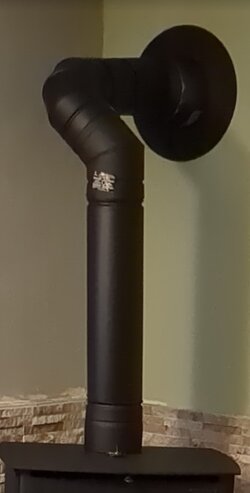Hi Everyone - Did a good amount of researching the topic before landing this post but couldn't seem to turn anything up. Recently installed a Lopi Evergreen wood stove in our finished basement doing a "through the wall" installation method with the chimney external to the house. I read manuals for the stove, stove pipe and chimney pipe extensively. Initial fire went very well with regards to draft with zero smoke coming in the house during any portion.
The issue: When the stove is NOT in use: I noticed that my interior stove pipe (model below) was getting extremely cold and creating condensation on the outside of the pipe. Every single joint of the interior double wall pipe was also leaking cold air heavily, as in, I could simply feel it blowing on my fingers when putting them near a joint. The corner where the stove was also getting extremely cold. I made sure the air control and the bypass were closed on the stove itself. There is no other damper in the stove pipe or chimney pipe. The 7-8" of Chimney pipe that enters the house did not sweat (or at least wasn't in the time period I was keeping track of the problem).
Outside Temperature: 20 degrees
Model Stove Pipe: 6" Selkirk Double Wall Stove Pipe DSP
Model Chimney: 6" Selkirk Doublewall Supervent Class A
Temporary fix: I'm not very fond of this for obvious reasons, is to go on the outside and stuff some insulation in the T section of chimney pipe when it isn't in use, this stops all air infiltration issues.
Other options I've considered after reading around:
Thank you in advance for any thoughts/help, I've been reading this forum for quite a while now and received tons of good & logical information.

The issue: When the stove is NOT in use: I noticed that my interior stove pipe (model below) was getting extremely cold and creating condensation on the outside of the pipe. Every single joint of the interior double wall pipe was also leaking cold air heavily, as in, I could simply feel it blowing on my fingers when putting them near a joint. The corner where the stove was also getting extremely cold. I made sure the air control and the bypass were closed on the stove itself. There is no other damper in the stove pipe or chimney pipe. The 7-8" of Chimney pipe that enters the house did not sweat (or at least wasn't in the time period I was keeping track of the problem).
Outside Temperature: 20 degrees
Model Stove Pipe: 6" Selkirk Double Wall Stove Pipe DSP
Model Chimney: 6" Selkirk Doublewall Supervent Class A
Temporary fix: I'm not very fond of this for obvious reasons, is to go on the outside and stuff some insulation in the T section of chimney pipe when it isn't in use, this stops all air infiltration issues.
Other options I've considered after reading around:
- Furnace cement on the DSP joints.
- Pro: Looks like it would seal the joints themselves so air would stop.
- Cons: The pipe is still going to sweat and create condensation on the outside, dripping onto stove and floor.
- Note: I'm OK with a semi-permanent solution here, as in, needing to reapply once a year, but the con pretty much overrules this as the sole solution.
- Damper: I looked into dampers but most of them seem to be 80% close rate.
- Pro: Easy to install? Or possibly none as they all seem to be 80%.
- Con: At 80% i don't think it is going to provide the closure I need to stop the air.
- Lopi Evergreen Stove
- Stove Adapter
- 24" Pipe
- 90 degree pipe
- 45 degree pipe
- 6" Pipe
- Universal Chimney Adapter
- Stove Pipe Adapter (connecting to Chimney)
- 18" Chimney Pipe through a Wall Thimble and connected to a Chimney Pipe "T" which then runs straight up the wall 24'
Thank you in advance for any thoughts/help, I've been reading this forum for quite a while now and received tons of good & logical information.


